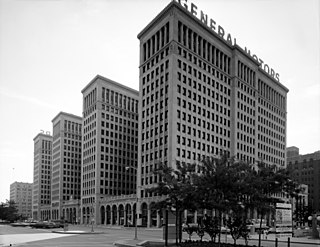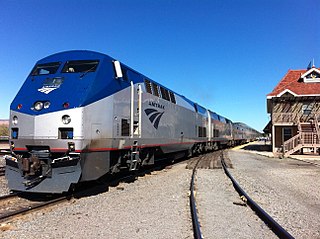Related Research Articles
The vast majority of passenger travel in the United States occurs by automobile for shorter distances and airplane or railroad for longer distances. Most cargo in the U.S. is transported by, in descending order, railroad, truck, pipeline, or boat; air shipping is typically used only for perishables and premium express shipments. Transportation is the largest source of greenhouse gas emissions in the United States.

Light rail transit (LRT) is a form of passenger urban rail transit characterized by a combination of tram and rapid transit features. While its rolling stock is similar to that of a traditional tram, it operates at a higher capacity and speed and often on an exclusive right-of-way. In many cities, light rail transit systems more closely resemble, and are therefore indistinguishable from, traditional underground or at-grade subways and heavy-rail metros.

The United States Department of Transportation is one of the executive departments of the U.S. federal government. It is headed by the secretary of transportation, who reports directly to the president of the United States and is a member of the president's Cabinet.

The Federal-Aid Highway Act of 1973 is legislation enacted by the United States Congress and signed into law on August 13, 1973, which provided funding for existing interstate and new urban and rural primary and secondary roads in the United States. It also funded a highway safety improvement program, and permitted states for the first time in U.S. history to use Highway Trust Fund money for mass transit. The law also established the first national speed limit.

The General Motors streetcar conspiracy refers to the convictions of General Motors (GM) and related companies that were involved in the monopolizing of the sale of buses and supplies to National City Lines (NCL) and subsidiaries, as well as to the allegations that the defendants conspired to own or control transit systems, in violation of Section 1 of the Sherman Antitrust Act. This suit created lingering suspicions that the defendants had in fact plotted to dismantle streetcar systems in many cities in the United States as an attempt to monopolize surface transportation.
Councils of governments are regional governing and/or coordinating bodies that exist throughout the United States. CoGs are normally controlled by their member local governments, though some states have passed laws granting CoGs region-wide powers over specific functions, and still other states mandate such councils.

The American Public Transportation Association (APTA) is a nonprofit group of approximately 1,500 public and private sector member organizations that promotes and advocates for the interests of the public transportation industry in the United States.

Paratransit is the term used in North America, also known by other names such as community transport (UK), for transportation services that supplement fixed-route mass transit by providing individualized rides without fixed routes or timetables. Paratransit services may vary considerably on the degree of flexibility they provide their customers. At their simplest they may consist of a taxi or small bus that will run along a more or less defined route and then stop to pick up or discharge passengers on request. At the other end of the spectrum—fully demand responsive transport—the most flexible paratransit systems offer on-demand call-up door-to-door service from any origin to any destination in a service area. In addition to public transit agencies, paratransit services may be operated by community groups or not-for-profit organizations, and for-profit private companies or operators.

The Federal Railroad Administration (FRA) is an agency in the United States Department of Transportation (DOT). The agency was created by the Department of Transportation Act of 1966. The purpose of the FRA is to promulgate and enforce rail safety regulations, administer railroad assistance programs, conduct research and development in support of improved railroad safety and national rail transportation policy, provide for the rehabilitation of Northeast Corridor rail passenger service, and consolidate government support of rail transportation activities.

The Federal Transit Administration (FTA) is an agency within the United States Department of Transportation (DOT) that provides financial and technical assistance to local public transportation systems. The FTA is one of ten modal administrations within the DOT. Headed by an Administrator who is appointed by the President of the United States, the FTA functions through Washington, D.C headquarters office and ten regional offices which assist transit agencies in all states, the District of Columbia, and the territories. Until 1991, it was known as the Urban Mass Transportation Administration (UMTA).
The Urban Mass Transportation Act of 1964 provided $375 million for large-scale urban public or private rail projects in the form of matching funds to cities and states. The Urban Mass Transportation Administration was created. It provided capital grants for up to 50% of the cost of transit improvements.
The Urban Mass Transportation Act of 1970 added to the Urban Mass Transportation Act of 1964 by authorizing an additional $12 billion of the same type of matching funds.

The Surface Transportation Assistance Act of 1982 was a comprehensive transportation funding and policy act of the United States Federal Government, 96 Stat. 2097. The legislation was championed by the Reagan administration to address concerns about the surface transportation infrastructure. The Act contained Title V, known as the Highway Revenue Act of 1982, which added five cents to the per gallon gas tax, of which four cents was dedicated to restore interstate highways and bridges, and one cent for public transit. The Act also set a goal of 10 percent for participation of disadvantaged business enterprises in federal-aid projects.
The Massachusetts Department of Transportation (MassDOT) oversees roads, public transit, aeronautics, and transportation licensing and registration in the US state of Massachusetts. It was created on November 1, 2009, by the 186th Session of the Massachusetts General Court upon enactment of the 2009 Transportation Reform Act.
The Demonstration Cities and Metropolitan Development Actof 1966 was enacted by the United States Congress to guarantee that federal grants were being spent on set projects in urban redevelopment. It was enacted as a broad urban planning program meant to revitalize cities and improve the welfare of people living in underdeveloped neighborhoods. The act provided aid to cities rebuilding blighted areas, while also offering measures that dealt with mass transit, beautification, conservation, water and air quality, public safety, and support for the arts and humanities.

The United States is serviced by a wide array of public transportation, including various forms of bus, rail, ferry, and sometimes, airline services. Most established public transit systems are located in central, urban areas where there is enough density and public demand to require public transportation. In more auto-centric suburban localities, public transit is normally, but not always, less frequent and less common. Most public transit services in the United States are either national, regional/commuter, or local, depending on the type of service. Sometimes "public transportation" in the United States is an umbrella term used synonymously with "alternative transportation", meaning any form of mobility that excludes driving alone by automobile. This can sometimes include carpooling, vanpooling, on-demand mobility, infrastructure that is oriented toward bicycles, and paratransit service. There is public transit service in most US cities.
The HUD Reports were a series of studies in mass transit systems, funded by the Urban Mass Transportation Administration (UMTA) department of the United States Department of Housing and Urban Development (HUD). The HUD reports were extremely influential in the development of the personal rapid transit (PRT) concept, small pod-like vehicles that automatically travel from point-to-point in extended networks. Their publication in early 1968 sparked off PRT development projects at dozens of companies around the world. In spite of intense interest in the early 1970s, political winds shifted and today there is only one HUD-inspired PRT system in commercial operation, the Morgantown PRT in West Virginia.
United States enterprise law is the body of law concerning networks, platforms, utilities, public services and the regulation of other enterprises or business entities. It is based on federal statutes, state statutes, and case law, that seek to guarantee human rights, particularly economic and social rights.
Bill "Billy" Richard Stokes was a mass transportation specialist and advocate most famous for being the General Manager of the San Francisco Bay Area Rapid Transit (BART) District during the initial construction and start of service of BART.
Transbus was announced in December 1970 as a United States Urban Mass Transportation Administration (UMTA) program to develop improvements to existing transit bus design; at the time, the US bus market was dominated by the GM New Look and Flxible New Look buses, and bus ridership was declining. The improvements had been suggested earlier by the National Academy of Sciences in 1968 to improve operating costs, reduce pollution, and stimulate ridership, and included innovations such as a low floor for easier entry and seats cantilevered from the wall to expand passenger space.